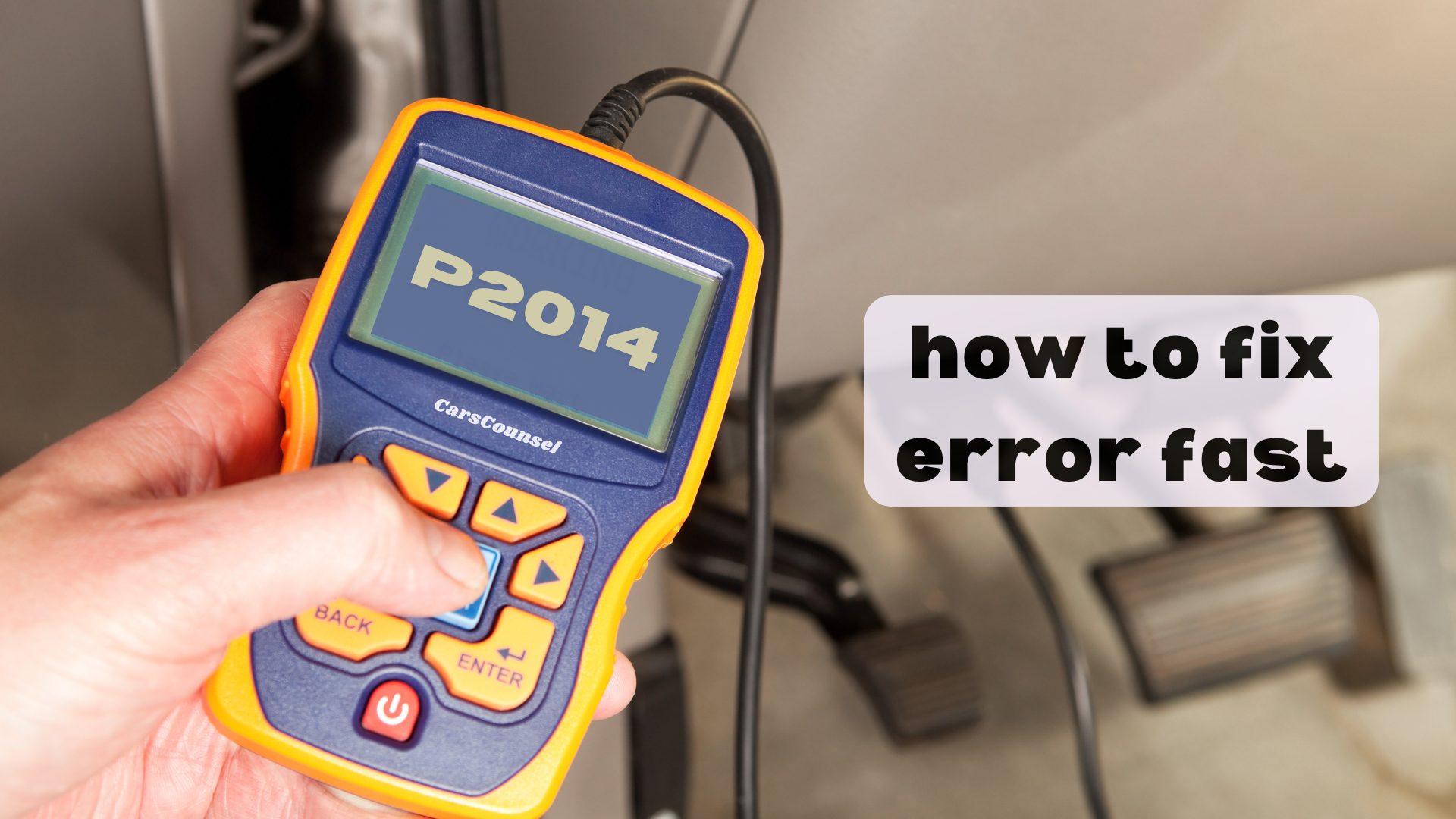You’ve got the P2014 code and need a quick fix. First, use an OBD-II scanner to confirm the error code and look for any related trouble codes. This is an important first step, but there’s more to do.
You should also check the intake manifold runner control valve, wiring, and connectors for any damage or loose connections.
Wondering what to do next to get your car running smoothly again? Keep reading to find out.

Quick Navigation
Key Takeaways
- Check the Wiring and Connectors: Look for any damage or loose connections in the wires and connectors linked to the intake manifold runner position sensor.
- Test the Sensor: Use a multimeter to check if the voltage readings of the intake manifold runner position sensor match the manufacturer’s specifications.
- Inspect the Control Valve: Make sure the intake manifold runner control valve moves smoothly and isn’t stuck by using a diagnostic tool to monitor its movement.
- Clean the Intake Manifold: Get rid of carbon deposits in the intake manifold to prevent blockages and ensure proper airflow.
What Is the P2014 Code?
The P2014 code means there’s a problem with the Intake Manifold Runner Position Sensor/Switch Circuit Bank 1, which is important for keeping your engine running smoothly.
This sensor checks the position of the intake manifold runner to make sure the right amount of air is going into the engine. If something goes wrong with this sensor, it can mess up the air flow, leading to poor engine performance.
This issue is common in vehicles with V6 or V8 engines. The intake manifold is crucial because it helps deliver the right amount of air to the engine cylinders.
When the sensor or switch circuit doesn’t work properly, your engine can’t ‘breathe’ well, which affects its efficiency and power.
Fixing this problem quickly is important to keep your vehicle running well and to maintain good fuel economy.
Symptoms of the P2014 Code
If your car has a P2014 code, you might notice some problems like rough idling, poor acceleration, and using more fuel than usual.
These issues happen because there’s a problem with the Intake Manifold Runner Position Sensor/Switch Circuit Bank 1. This code can really mess with your car’s performance and how efficiently it uses fuel.
It’s important to fix rough idling and poor acceleration quickly to keep your engine running well. Using more fuel is another key sign that needs attention right away.
Regularly checking and maintaining your intake manifold can help avoid these problems and make sure everything works as it should. Watching out for these symptoms can save you from bigger issues later on.
Common Causes
Several things can cause the P2014 code, mainly related to the intake manifold runner control system.
A common issue is a stuck intake manifold runner control valve, which messes up the airflow and lowers performance.
Electrical problems like damaged or disconnected wires can also set off this code.
A broken intake manifold runner position sensor gives wrong readings, affecting engine performance.
Additionally, a faulty intake manifold runner control solenoid can restrict air flow into the engine.
Lastly, regular wear and tear from long-term use can make these parts fail.
Fixing these problems quickly is important to keep your car running well.
Affected Vehicles
Affected Vehicles
Among the vehicles affected by the P2014 code, Dodge Avenger and Chrysler Sebring models from 2007 and 2008 often have issues with the intake manifold runner control. Other models like the Jeep Patriot (2007-2016), Ford Mustang, and Chevrolet Camaro also show similar problems. You can use diagnostic tools to compare vehicles and see how widespread the issue is.
| Vehicle Model | Affected Years | Common Issue |
|---|---|---|
| Dodge Avenger | 2007-2008 | Intake manifold runner control failure |
| Chrysler Sebring | 2007-2008 | Intake manifold runner control failure |
| Jeep Patriot | 2007-2016 | Intake manifold runner issues |
| Ford Mustang | Various years | Intake manifold runner sensor problems |
Knowing these common issues can help you focus your diagnostics more effectively.
Initial Diagnosis Steps
Initial Diagnosis Steps
Start diagnosing the P2014 code by connecting an OBD2 scanner to the vehicle’s diagnostic port to check for any stored error codes. This will help you figure out if P2014 is the only problem or if there are other issues that need more detailed diagnostics.
Follow these basic troubleshooting steps:
- Check for other codes: Having multiple codes might mean bigger problems.
- Inspect wiring and connectors: Look for any signs of wear, damage, or loose connections.
- Test the intake manifold runner position sensor: Make sure it’s giving accurate readings.
- Examine the runner control valve: Check if it’s working properly.
These steps will give you a good starting point for more detailed troubleshooting.
Inspecting the Control System
After completing the initial diagnosis steps, focus on checking the intake manifold runner control system to find any specific problems. Start by visually examining the system’s parts for any signs of damage or disconnection. Pay close attention to the wiring and connectors, as any issues with these can easily cause error codes.
| Component | Action |
|---|---|
| Intake Manifold Runner | Look for physical damage |
| Control System Wiring | Check for cuts or frays |
| Electrical Connectors | Make sure connections are secure |
| Position Sensor | Ensure it is properly placed |
Check each part to make sure it is working correctly. If you find any wear or damage, it could be causing the error codes. Replacing or fixing these parts will help the intake manifold work properly.
Testing the Control Valve
Check if the intake manifold runner control valve is working right by using a diagnostic tool to see if it moves and responds properly. This is important to make sure the valve is doing its job.
First, connect your diagnostic tool to the car’s OBD2 port. Watch how the valve behaves when you run the engine at different RPM levels. Make sure the valve opens and closes smoothly without any sticking.
Testing the control valve properly can stop other problems from happening and help your engine run better.
- Avoid headaches: Prevent recurring problems.
- Get answers fast: Find the issue quickly and accurately.
- Trust your car: Know your vehicle is performing well.
- Save time and money: Use precise diagnostics to fix issues efficiently.
Sensor Testing Procedures
To test the intake manifold runner position sensor, connect your multimeter to the sensor’s terminals and check for the correct voltage readings as specified in your vehicle’s service manual.
Make sure the sensor is calibrated correctly by comparing your readings to what the manufacturer recommends.
Use diagnostic tools to confirm that the sensor’s output is within the expected range while the engine is running.
If the readings are off, the sensor might be faulty and need to be replaced.
Also, check the sensor’s wiring and connectors for any signs of damage.
Regularly testing the intake manifold runner position sensor helps keep your engine running smoothly and prevents the P2014 code from coming back.
Accurate sensor calibration is crucial for reliable diagnostics.
Repair Solutions
Once you’ve confirmed that the intake manifold runner position sensor is working properly, here are some straightforward solutions to fix the P2014 code:
- Repair or replace the control valve: Costs can vary depending on your vehicle.
- Fix electrical issues: Check and fix any damaged wires or connections to get things working again.
- Replace the position sensor: If needed, have a professional install it to ensure it’s done correctly.
- Change the control solenoid: Make sure a skilled mechanic handles the installation.
These steps will help you fix the P2014 code, keeping repair costs down and ensuring your vehicle runs smoothly.
Preventive Maintenance
Regular preventive maintenance is key to avoiding the P2014 code and keeping your vehicle running smoothly.
Start by regularly checking the intake manifold runner control system for any wear, damage, or loose connections. Cleaning the intake manifold and related parts can stop buildup and ensure good airflow.
Follow the manufacturer’s advice, like changing the oil and air filters on time, to keep your engine in great shape.
Also, use diagnostic tools now and then to catch any issues early.
More OBD-II Codes
Frequently Asked Questions
Can a P2014 Code Affect My Vehicle’s Emissions Test Results?
Yes, a P2014 code can affect your vehicle’s emissions test. It means there are problems with the intake manifold, leading to poor engine performance and higher emissions, which can cause your car to fail the test.
What Tools Do I Need to Diagnose the P2014 Code?
To figure out what’s causing the P2014 code, you’ll need a diagnostic scanner and some basic troubleshooting steps. Look for any damaged wiring, and test the intake manifold runner control valve and position sensor to find the problem.
How Long Does It Take to Fix the P2014 Code?
Fixing the P2014 code usually takes between 1 to 3 hours, depending on the exact problems. The time it takes can vary based on whether you’re dealing with electrical issues, changing sensors, or repairing the control valve.
Can I Drive My Car With a P2014 Code?
You can drive your car with a P2014 code, but it’s not a great idea. This code can cause rough idling and poor acceleration. Problems like a faulty intake manifold runner control valve can get worse and mess up your engine’s performance.
Is It Expensive to Fix the P2014 Code Issue?
Worried about repair costs? Don’t be; fixing the P2014 code can cost anywhere from $100 to $500, depending on whether you need to replace the valve, sensor, or fix electrical problems.
Conclusion
In short, fixing the P2014 code involves careful checks and quick action.
If your car’s check engine light is on and an OBD-II scan shows the P2014 code, start by looking at the intake manifold runner control valve and related parts.
Cleaning off carbon buildup and replacing any bad parts can fix the problem quickly.
Regular maintenance checks can help keep this issue from coming back, making sure your car runs smoothly and avoids future problems.

